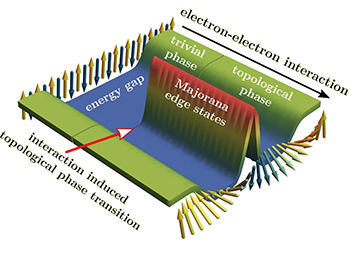Inducing Topological Phase Transitions by Correlation Effects
December 20, 2021
Courtesy of Distinguished Professor Elbio Dagotto
Topological phases of matter, the science behind the 2016 Nobel Prize, are an exciting landscape for physicists who routinely investigate the workings of particles and forces, down at the atomic level. A topological insulator, for example, has an insulating interior but currents at its surface. Exotic “topological” superconductivity can arise at that surface, when the material is in contact with a regular superconductor. Other exotic effects, such as dissipation-less currents, can have topological origin opening the way towards quantum computing, allowing the potential to solve scientific problems requiring powerful simulations or machine learning resources. There is yet another component in the family of exotic new states that scientists unveiled in recent times: the Majorana fermions. These Majorana fermions have been known within particle physics since they were predicted in the 1930s. The Majoranas have zero charge and they are their own antiparticle. More recently, in Condensed Matter Physics it was noticed that Majoranas could develop in superconductors because the effective particles in superconductors (quasiparticles) are their own antiparticle. But while the concept is interesting and robust, confirming its existence in real materials is far more challenging.

Distinguished Professor Elbio Dagotto and colleagues have recently shown that competing energy scales and states induced by electronic correlations in iron-based superconducting systems can usher in a topological phase transition that produces Majoranas. The findings were recently published in Nature Communications. The main result is illustrated in the figure. In the complex phase diagram of a special family of one-dimensional materials, it was predicted that an exotic “spiral” could develop. The material is one dimensional in the sense that in the crystal structure the dominant portion that produces its physical properties arises from atoms close to one another along chains.
The spins in these spirals are neither ferromagnetic nor antiferromagnetic (both collinear, namely all pointing along the same line), but they could also arrange their spins such that they are only slightly tilted one next to the other along the chain, leading to a non-collinear “spiral” arrangement. Such a spiral was found to exist only in the presence of robust correlation effects, namely not for weakly interacting electrons. Once the spiral is brought next to a standard superconductor, the tendencies towards superconductivity penetrate into the spiral in what is widely known as “proximity effect.” The remarkable result found in the Nature Communications publication mentioned above is that in this framework at the edges of a finite-length spiral chain, Majoranas were detected in computer simulations. The figure illustrates that before the strength of correlation reaches a critical value, the spins are “collinear” (see arrows on the top left) and the induced superconductor has a regular “energy gap.” When the critical value is reached, the spins twist into a spiral (arrows at bottom right) and induce Majoranas at the edges of the chain. The results provide a novel avenue towards the physical realization of Majoranas that awaits experimental confirmation.